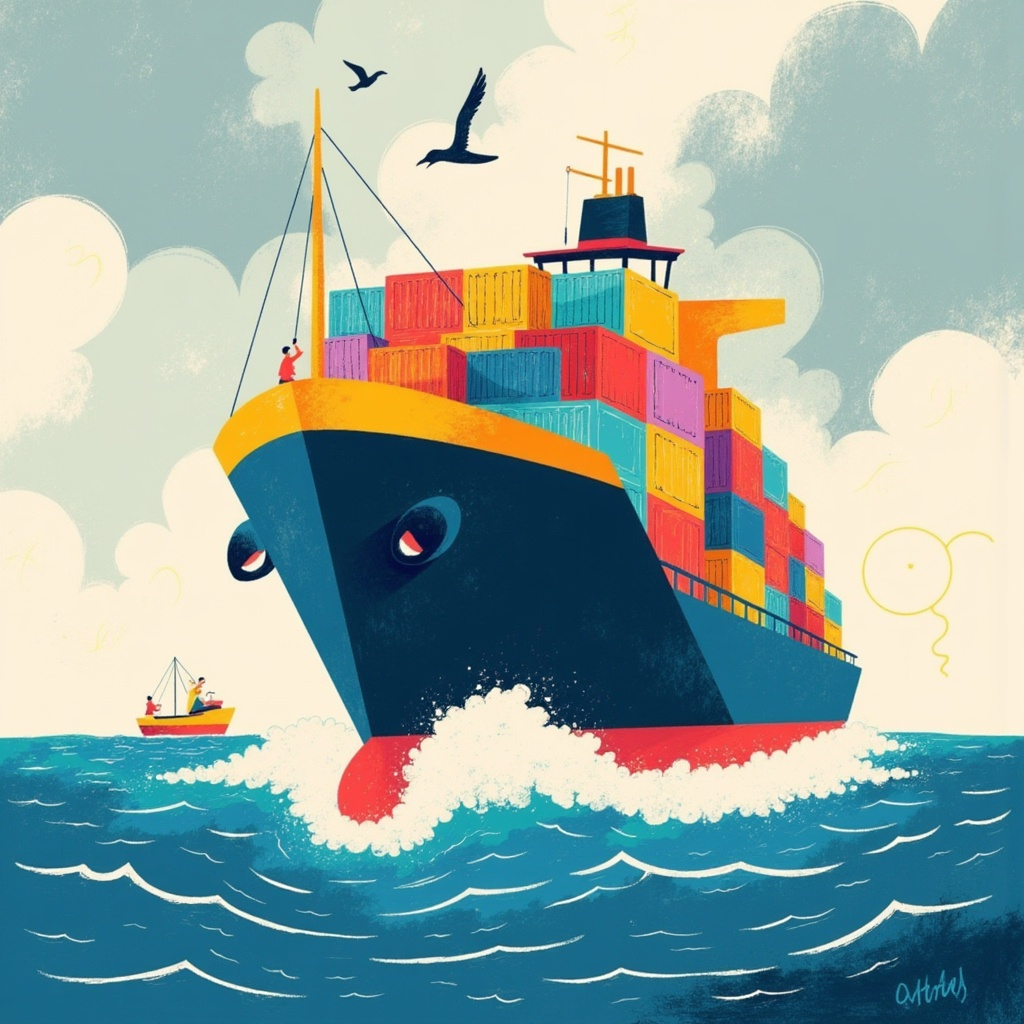What Is a Freight Forwarder (and Why Every Product Brand Needs One)
You’ve found the perfect factory. Your prototypes are done, your production run is scheduled, and the samples look great. But your job isn’t finished... not even close.
The next critical step in getting your product into customers’ hands is shipping, and that’s where many brands hit unexpected snags. Getting products from a factory to your warehouse (or straight to customers) involves multiple stages, international coordination, and a maze of paperwork that can derail your timeline and erode profit margins.
Even if your product is designed flawlessly, failing to manage logistics properly can make or break your launch. This is why working with a reliable freight forwarder isn’t optional, it’s essential.
What Exactly Is a Freight Forwarder?
A freight forwarder is a company that coordinates and manages the transportation of your goods from the factory to your final destination. Think of them as your global shipping project manager.
Freight forwarders don’t necessarily own ships, planes, or trucks. Instead, they specialize in navigating the complex logistics of international trade: consolidating shipments, booking cargo space, preparing customs documents, arranging insurance, and ensuring your goods move smoothly through every stage of the supply chain.
Their job is to make global shipping seamless, so your team doesn’t have to deal with customs forms, carrier negotiations, or port congestion problems.
If your factory is overseas (for example, in China, Vietnam, or Mexico, three common manufacturing regions we help clients navigate at Klugonyx), your freight forwarder becomes the linchpin between your production and fulfillment.
The Three Main Stages of Global Shipping
Shipping is more than loading a container and waiting for delivery. It’s a coordinated process that moves your products across multiple legs of transportation.
1. Factory to Port (Origin Transportation)
Once production is complete, your goods need to be transported from the factory floor to the port of export. This might involve trucks or rail depending on distance and infrastructure. A freight forwarder arranges this pickup, ensures proper packaging and labeling, and coordinates with local carriers to get the shipment cleared for export.
2. Port to Port (International Freight Shipping)
This is the international leg of the journey. Your freight forwarder books space on a vessel or aircraft, usually under FOB (Free on Board) or EXW (Ex Works) shipping terms, and ensures the goods are properly loaded, insured, and tracked in transit. Whether by sea or air, they manage all documentation, including bills of lading, packing lists, and export declarations.
3. Port to Final Destination (Destination Transportation)
Once the shipment lands, it still needs to be cleared through customs, unloaded, and delivered to its final destination, your warehouse, fulfillment center, or even direct to Amazon FBA. Freight forwarders coordinate these final legs, handling duties, tariffs, and delivery scheduling so your product doesn’t sit idle at the dock.
Each leg involves dozens of checkpoints, potential handoffs, and compliance steps, all of which a seasoned freight forwarder manages for you.
Why Many Factories Don’t Handle Shipping
One of the biggest misconceptions in manufacturing is assuming the factory will handle shipping logistics. While some offer basic export support, most factories stop their responsibility at the factory gate.
Factories focus on producing your goods, not managing international logistics. Once your order is packed and ready, they’ll expect you (or your appointed agent) to handle pickup, documentation, and freight coordination.
If you don’t have a freight forwarder in place, this is where issues start: containers sitting unbooked, missed vessel deadlines, or incomplete paperwork that prevents export clearance. Each of those mistakes can cost thousands and delay your launch by weeks.
At Klugonyx, we often step in during this critical phase, not as freight forwarders ourselves, but as the strategic liaison between your factory and your logistics partner. Our role is to make sure your factory’s output connects seamlessly to your freight plan, helping you avoid common pitfalls.
What a Freight Forwarder Actually Does
If you’ve never worked with one, it’s easy to underestimate how much a freight forwarder handles behind the scenes. Here’s what they do on your behalf, often saving you from major headaches.
They handle all customs paperwork
From commercial invoices to certificates of origin and HS codes, customs paperwork is complex and varies by country. A forwarder ensures every document is complete and compliant, which helps your shipment clear borders faster and without surprise fees.
They ensure tariff and import compliance
With trade policies and tariff rules changing frequently, especially for products coming from China, a good forwarder keeps you compliant. They work alongside customs brokers to correctly classify goods under the Harmonized Tariff Schedule, preventing misclassification penalties or unexpected duties.
If you’re sourcing outside of China, as many of our clients are, they’ll also help navigate varying import taxes in regions like Vietnam, India, or Mexico.
They reduce the risk of shipping delays
Freight forwarders monitor global shipping conditions, coordinate with carriers, and reroute or expedite when necessary. They know which ports are congested, which carriers are reliable, and how to avoid common pitfalls like container rollovers or customs holds.
Shipping delays are more common than you might think, particularly during peak seasons or when geopolitical tensions disrupt trade routes. Having an experienced freight forwarder can be the difference between a one-week delay and a six-week crisis.
Why Shipping Delays Can Be Devastating
A single delay can ripple through your entire business.
If you’ve taken pre-orders through Kickstarter, an e-commerce platform, or a retailer expecting launch inventory, a delayed shipment can erode trust, damage your reputation, and trigger refund requests.
Beyond customer frustration, delays can cause warehouse scheduling conflicts, missed trade show opportunities, and increased storage fees when goods sit at port awaiting clearance.
In a world where consumer expectations for delivery speed are higher than ever, the cost of poor logistics can exceed the cost of production mistakes.
Having a freight forwarder doesn’t eliminate every risk, but it dramatically reduces the chance of those risks becoming reality.
How Freight Forwarders Fit Into Your Supply Chain Strategy
At Klugonyx, we view freight forwarding as one piece of the broader supply chain puzzle. Our role often includes selecting and coordinating with vetted logistics partners who specialize in your product category, region, and shipping method.
When we help clients produce goods in countries like Vietnam, India, Indonesia, or Mexico, we align DFM (Design for Manufacturing) principles with freight planning early in the process. This ensures the product is packaged, labeled, and containerized efficiently, reducing shipping cost per unit and minimizing risk of damage.
For example, we may design packaging that optimizes pallet fitment, reinforces load-bearing edges, or minimizes airspace within cartons. Small design changes like these can save hundreds or thousands in freight costs over time. (See how our Product Design & Engineering Services integrate these considerations.)
By embedding logistics thinking early, you prevent last-minute surprises like oversized packaging, mislabeled cartons, or container inefficiencies that drive up cost.
Key Terms You’ll Hear When Working With a Freight Forwarder
If this is your first time dealing with international logistics, you’ll encounter industry terms that can seem intimidating. Here’s what they mean in practical terms:
- FOB (Free On Board): The factory is responsible for getting the goods to the port and loaded onto the ship. From that point forward, you (the buyer) assume cost and risk.
- EXW (Ex Works): You assume responsibility as soon as the goods leave the factory. Your forwarder handles everything from pickup to final delivery.
- LCL (Less than Container Load): Your products share container space with other shipments, good for smaller runs but slower.
- FCL (Full Container Load): You fill an entire container, faster, more secure, and often cheaper per unit for larger volumes.
- Bill of Lading (BOL): The master shipping document proving ownership of the goods in transit. Your freight forwarder issues and manages this.
Understanding these terms helps you make smarter decisions and communicate effectively with your forwarder and suppliers.
Choosing the Right Freight Forwarder for Your Business
Selecting a freight forwarder isn’t about finding the cheapest quote, it’s about finding the partner who understands your product, timeline, and risk tolerance.
Here are some traits to look for (and ones we value when recommending forwarders to Klugonyx clients):
- Industry experience: Do they have experience shipping consumer goods like yours? Fragile, regulated, or perishable items require specialized handling.
- Global network: Forwarders with offices or agents in your manufacturing country can respond faster when issues arise.
- Transparency: Reliable partners provide real-time shipment tracking, clear breakdowns of fees, and open communication about potential risks.
- Customs expertise: The best forwarders have in-house customs brokers or partnerships with top-rated brokerage services.
Working with a forwarder who understands your product type, whether it’s a baby product subject to CPSIA, a wellness device requiring FDA classification, or a pet accessory with retail packaging, helps ensure you remain compliant and on schedule.
How Freight Forwarders Complement Klugonyx’s End-to-End Support
While Klugonyx doesn’t directly operate as a freight forwarder, we work hand-in-hand with them to close the gap between production and logistics.
Here’s how the collaboration typically works:
- We manage factory coordination, QC, and export readiness
- The freight forwarder manages transportation, customs, and delivery
- Together, we ensure seamless communication between the factory, forwarder, and you, preventing costly misalignment
In short, we make sure that when your product leaves the factory, it’s on the right truck, with the right documents, heading to the right port, and ultimately, to the right destination.
Our clients often tell us this phase used to be their biggest stress point. Now, it’s a smooth transition they barely have to think about.
Final Thoughts: Your Supply Chain Doesn’t End at the Factory Door
Finding the right manufacturer is only half the battle. Your success depends just as much on getting products shipped efficiently, safely, and on time.
Working with a trusted freight forwarder ensures your goods clear customs, avoid unnecessary delays, and arrive exactly where they need to be, protecting your cash flow, your brand reputation, and your customer relationships.
And when your logistics plan is coordinated alongside design, engineering, and sourcing, as it is with Klugonyx’s global manufacturing support, you gain full visibility across your supply chain, from concept to customer.
Whether you’re moving your first pallet or managing hundreds of containers per year, don’t treat freight forwarding as an afterthought. It’s the silent backbone that keeps your product moving, and your business growing.




